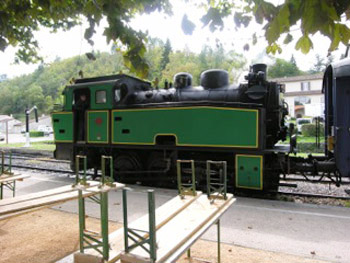
by Glen Cowley
Its long grey breath trailing in smoky gasps the iron dragon pushed its nose into the looming darkness of the beckoning mountain.
From Saint-Jean-du-Gard the Train Touriste a Vapeur des Cevennes wends it way through southern France’s Cevenne Mountains, the 13 winding kilometres to Anduze; burrowing its way through tunnels, leaping the River Gardon and hugging mountainsides. Nature’s vistas and mankind’s legacies explode into view with every turn and twist.
Since 1909 steam and diesel engines have been labouring through the Gardon Valley between Saint Jean and Anduze, their fortunes rising and falling with the vagaries of economies and technology. Saved from its demise by popular support the operation safely landed in community hands and has been running as a tourist train since 1982. Some 30,000 people a year board the period passenger cars and lurch into motion behind one of the six steam or diesel locomotives for the one way or return journey between the two towns.
 Our trip began with a short walk from the bus stop at Saint-Jean-du-Gard, treading the bridge over the historic Gardon River, to the the small square abutting the quaint train station. Our locomotive was already huffing and puffing in anticipation; its passengers choosing their carriages with puzzled analysis. Chatter proved easy between travellers and we struck up conversation with a gentleman from a small town in England who popped down to the south for a brief one week junket as he was wont to do on occasion.
Our trip began with a short walk from the bus stop at Saint-Jean-du-Gard, treading the bridge over the historic Gardon River, to the the small square abutting the quaint train station. Our locomotive was already huffing and puffing in anticipation; its passengers choosing their carriages with puzzled analysis. Chatter proved easy between travellers and we struck up conversation with a gentleman from a small town in England who popped down to the south for a brief one week junket as he was wont to do on occasion.
With a bump and grind and a huff and a puff we inched away from the station; the engine’s exertions gasping with smoking grunts. Nestling alongside the river our wending way took us through pastoral fields overlooked by low mountains shaded in greenery save where the greyish face of earth’s bones erupted or protruded; a sense of the tamed and the wild. Passengers poked noses out of windows to garner better views and gaze ahead at the engine snaking around the curves and bends. Viaducts spanned the lesser streams feeding into the Gardon, raising up vistas of the rising mountains as we passed. Houses, seemingly unassailable, peeked through the greenery. Just where the river broadened into an alluvial expanse the tunnel de la Salindrenque suddenly engulfed us in darkness, the echoes of the cars and the whiff of smoke invading our space. Heads pulled in to safety as we blindly felt the darkness pass.
Bursting into light we spanned a tributary and looked down upon the bony shores of the Gardon and its pure waters rushing beneath us. An old stone mill crowded the shoreline and bathers paused to watch our passing.
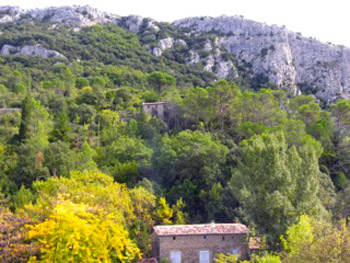 Slowly we ground to a halt for the Bambouseriae (Bamboo Garden) where those wishing to do so disembarked for a tour of this unique jungle that pulls in 150,000 visitors per year. The 10 hectare walk can eat up an hour and half easily so a visit takes some planning and scheduling. Fortunately the return trip comes through two hours later. From our perch high above the park we could espy the tangled canopy and winding trails.
Slowly we ground to a halt for the Bambouseriae (Bamboo Garden) where those wishing to do so disembarked for a tour of this unique jungle that pulls in 150,000 visitors per year. The 10 hectare walk can eat up an hour and half easily so a visit takes some planning and scheduling. Fortunately the return trip comes through two hours later. From our perch high above the park we could espy the tangled canopy and winding trails.
The two minute stop completed, those of us remaining aboard began the final, spectacular, advance upon the mountain guard of Anduze. A steep, white-faced escarpment rose dramatically to our left before we spun onto a tall, steel bridge over the Gardon and faced the looming visage of Mount Saint-Julien, rising almost a thousand feet above us. A mount once fortified during the Gallo-Roman and medieval periods. There was to be no long winding route around this singular natural edifice; we bore straight towards its rising body and the dark portal bespeaking the Tunnel d’Anduze. Swallowed into the blackness of the kilometre long tunnel we seemed to linger forever in the racing darkness until we were thrown blinking into the welcoming light and the easing lurch of our carriage to its Anduzian berth.
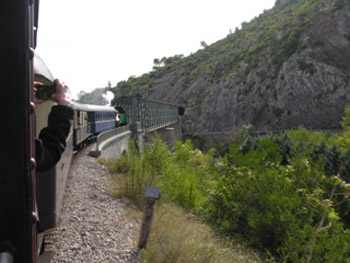 We were catching the bus back to Nimes from Anduze and so had leisurely time to explore this historical gateway to the Cevennes. For those taking the train back they had time for at least a quick stroll about town. Home to a population of 3000, down from its formative years, the Anduze area has evidence of habitation from prehistoric times and was a Gallo-Roman settlement. Here, in the 10th century, the Siegneurie of Anduze was established.
We were catching the bus back to Nimes from Anduze and so had leisurely time to explore this historical gateway to the Cevennes. For those taking the train back they had time for at least a quick stroll about town. Home to a population of 3000, down from its formative years, the Anduze area has evidence of habitation from prehistoric times and was a Gallo-Roman settlement. Here, in the 10th century, the Siegneurie of Anduze was established.
The tourism office is located in the main town square amply bordered by a ring of cafe’s tempting with coffee, cool beer, wine or treats (remembering, of course that wine is considered a food). The office, housed in one of the largest former temples in France (built between 1820 and 1823), an impressive structure dominating the square, provides a handy English language map of Anduze. The bus stop is but a peek around the corner away.
Small though it may be Anduze is no less a treat to the eye than any other southern French town and much is within an easy walk-about range. Central to the square rises the unique Tour de L’Horloge (clock tower) dating from 1320. Replete with a sundial, bell and proud Gallic rooster it managed to survive the destruction of the town’s ramparts in 1629.
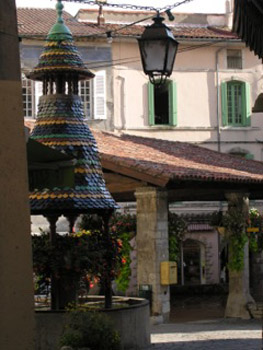 Anduze and its area was long a Protestant holdout during the terrible religious wars of France and suffered for it.
Anduze and its area was long a Protestant holdout during the terrible religious wars of France and suffered for it.
Fountains and squares abound. The Fountain Pagoda speaks to the unique evolution of the silk industry here. Built in 1648 in an eastern fashion it was funded by an Anduzian trader who had brought the industry here from Asia. Perhaps less profound but no less intriguing are the Fountain of the Bicenterary built in 1989 to celebrate the revolution, the Pradier Fountain, the Fountain of the Bridge and the Fountain of the Potters. Word is that there were even more fountains dating from the early 18th century but some were sacrificed to urban modernization.
Thursday morning markets are still housed in the covered market place originally constructed in 1457.
There is no concealing the heavy hand of tourism here yet like the stone construction of its buildings Anduze seems well able to absorb the tidal wash of its many visitors and emerge intact every morning.
We found our English counter part nursing a beer at a cafe; pausing to chat about our discoveries. So engaged we heard a whistle echo against the mountains. We listened as it trailed away into the bowels of mount Saint Julien, glad we had heard its song.
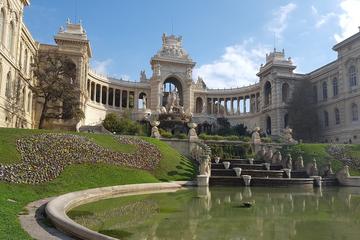
Marseille Shore Excursion: City Half-Day Sightseeing Tour of Marseille
If You Go:
♦ www.trainavapeur.com – webpage for the steam train. It runs daily from April 1 to August 31 then until November for 5 to 6 days a week. An adult return fare was 11 Euros and a child’s was €7.50. One way takes 40 minutes.
♦ www.map-france.com/saint-jean-du-gard-30270 – website for Saint-Jean-du-Gard
♦ www.beyond.fr/villages/anduze.html – website for Anduze
♦ www.bambouseraie.com – website for the Bambo Garden
About the author:
Since 1994 Glen Cowley has parlayed his interest in sports, travel and history into both books and articles. The author of two books on hockey and over fifty published article (including sports, biographies and travel) he continues to explore perspectives in time and place wherever his travels take him. From the varied landscapes of British Columbia to Eastern Canada and the USA, the British Isles, Germany, Switzerland, the Netherlands, Greece and France he has found ample fodder for features.
All photos are by Glen Cowley.



Leave a Reply
You must be logged in to post a comment.